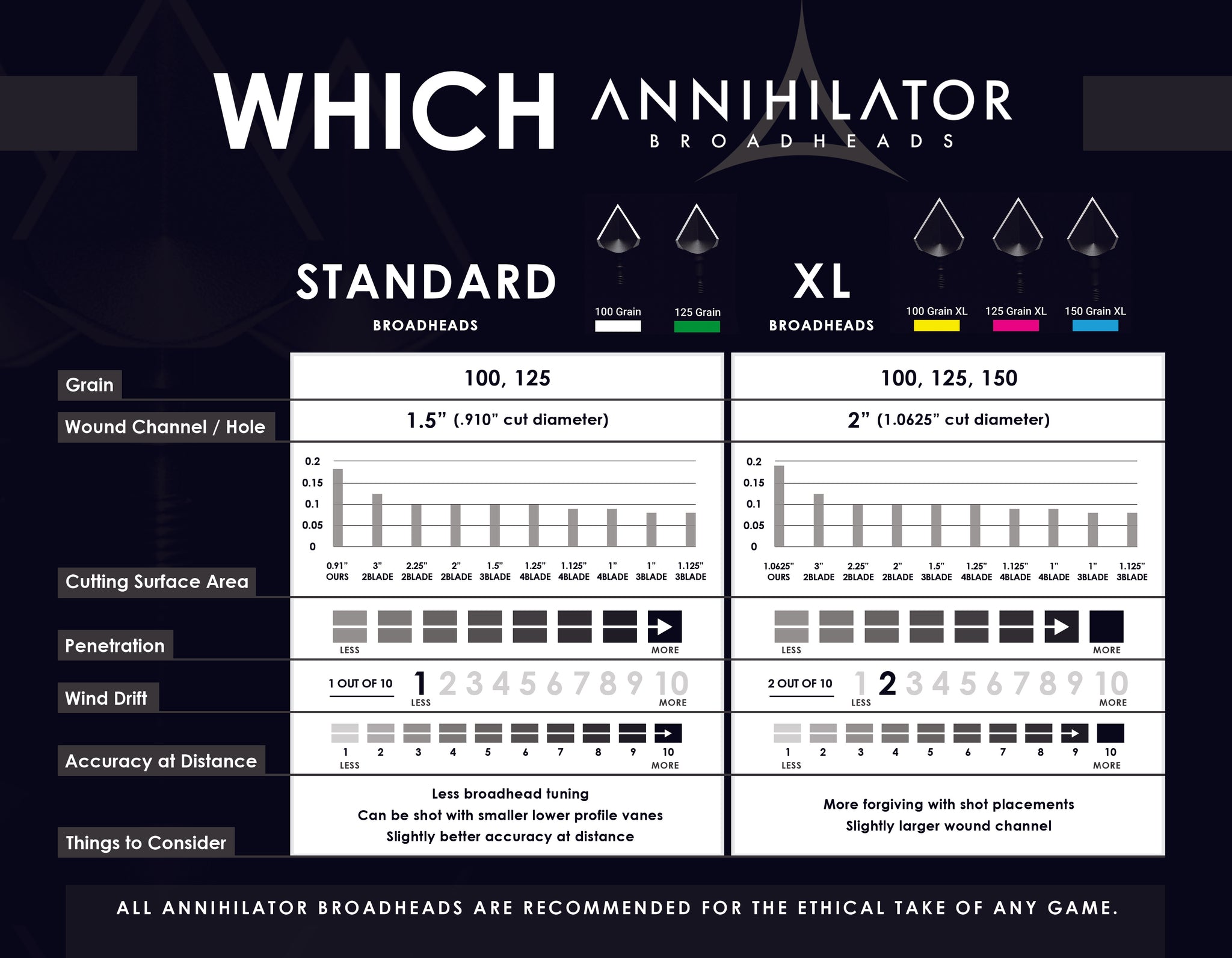Which Annihilators + Recommendations
Below are some general recommendations. Every setup is different so please test for yourself and discover what works best for you. Reach out to us if you require specific help.

Broadhead Selection
- If you are on the fence about which Annihilator to shoot, the vast majority of Annihilator customers shoot our standard size 100 grain broadhead which means the vast majority of reviews you may have read or photos you have seen regarding our heads are most likely from experience with our standard size heads.
- Standard size Annihilators should not require much if any broadhead tuning and can be shot with smaller lower profile vanes. On average they will penetrate only slightly deeper into ballistic gel than the XLs.
- Annihilator XLs will be slightly more forgiving with shot placements due to the larger cut diameter. They do produce larger holes in animals than the standard size Annihilators. For those wanting field point accuracy past 60 yards with XLs, you may experience some drop if your arrow speeds are less than 285 ft/s depending on your vane configurations. The slower the arrow speed the more this is compounded. To fix the drop, you can move your vanes back towards the nock a bit to adjust the center of pressure on the arrow. You can also try lighter-weight vanes in a 3 fletch with longer or taller vanes to generate more lift in the back to match the lift generated in the front by the larger surface area of that broadhead. Adding hard a helical may increase drop at longer distances given helical is meant to speed up the twist rate of the arrow faster off the bow but also slows down the arrow faster than a non-helical at distance.
- The standard shaft length on 100 grain Annihilators are .590" and are shorter than most other broadhead shafts. They may not allow for the recommended 2 full turns on some ethics inserts and HIT inserts (depending on where you glue in the HIT inserts). If you use ethics or HIT inserts you may consider jumping up to our 125 grain options for those shaft lengths are longer and will give you at least 1/2 of an additional turn.
Tuning and Set Up
- Every archer should walk back / french tune their rest before shooting broadheads. Paper tuning is only a start. Bare shaft tuning is an excellent next step (start at 10 yards then go to 20) but walk back tuning is the final step to fine tuning your bow and preparing for shooting broadheads. If you are unfamiliar with walk back tuning, there are tons of videos and articles available online which can be found with a quick Google or Youtube search. It takes ~15 minutes to walk back tune and will ensure your arrows cast off your rest properly. No matter which broadheads you shoot, you'll be able to tell the difference between broadheads that truly fly left and right like field tips vs those that don't. It also helps with left and right long range accuracy.
- For every shooter, we recommend a total point weight of 150 grains or higher or 13% FOC or higher including the point and insert/outsert. We highly recommend going to 15-18% FOC for an ideal balance between penetration and flight efficiency while keeping a flatter arrow trajectory. This will help cause your arrow to fly closer to a true ballistic trajectory so it has an increased penetration efficiency as it enters an animal and more stability in flight. This is our recommendation no matter which broadhead you shoot.
- Crossbow and traditional bow shooters should also consider higher FOC options like 125 grain heads or heavier or add more point weight with heavier inserts. Standard size Annihilators fly incredibly well out of high-speed crossbows at longer ranges.
- We also highly recommend going with a stiffer spine arrow for compound bow shooters no matter your bow set up. In all of our testing specific to hunting scenarios (not competitive target shooting), the stiffest spine arrows penetrate the furthest. The stiffer the arrow spine the less pitch and yaw an arrow has; therefore, a stiffer arrow will have increased penetration power upon impact into an animal and more efficiently transfer its existing kinetic energy (KE) into its target. To test your specific set up, shoot an arrow at dusk with a field point and lighted nock on the back at 20 yards into a solid foam target (not a bag target). You want to see what happens to the back of your arrow upon impact. If the back of your arrow still pitches and yaws after impact, you need to stiffen your arrow spine if you want to increase or maximize your penetration potential. If the arrow sticks into the target and you can see that the lighted nock just stops without significant movement (pitch and yaw), you have proof your arrow efficiently transferred all the KE into the target.
